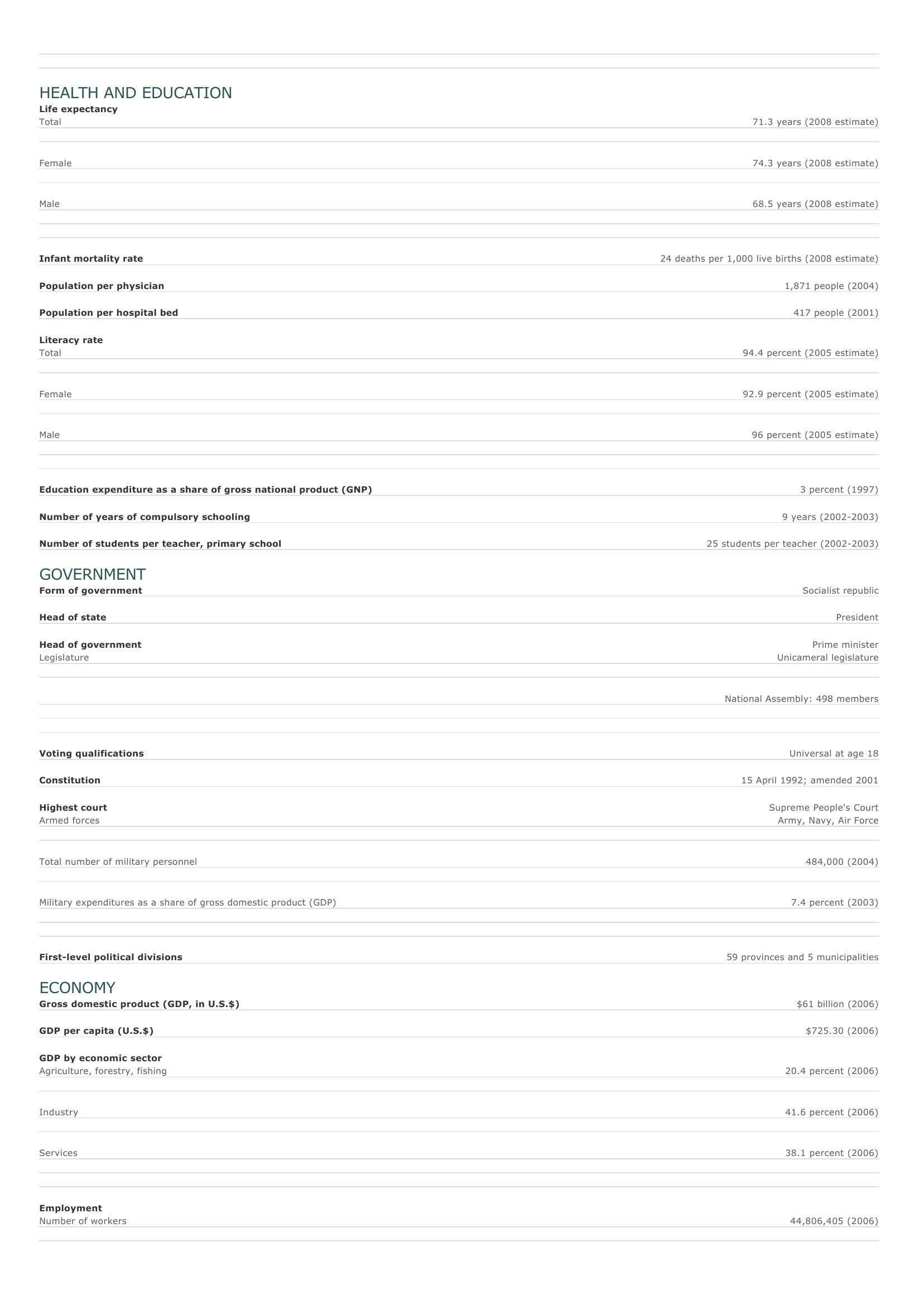
Vietnam Facts and Figures. BASIC FACTS Official name Capital Area Socialist Republic of Vietnam Hà N? i 331,690 sq km 128,066 sq mi PEOPLE Population 86,116,559 (2008 estimate) Population growth Population growth rate 0.99 percent (2008 estimate) Projected population in 2025 99,977,731 (2025 estimate) Projected population in 2050 107,772,641 (2050 estimate) Population density 265 persons per sq km (2008 estimate) 686 persons per sq mi (2008 estimate) Urban/rural distribution Share urban 27 percent (2005 estimate) Share rural 73 percent (2005 estimate) Largest cities, with population Ho Chi Minh City 6,105,800 (2006 estimate) Hà N? i 3,977,000 (2003 estimate) Haiphong 1,803,400 (2006 estimate) ? à Nang 382,674 (1992 estimate) Can Tho 215,587 (1992 estimate) Ethnic groups Vietnamese 90 percent Chinese 2 percent Khmer, Cham and other 8 percent Languages Vietnamese (official), Chinese, Khmer, Cham, other minority languages Religious affiliations Buddhist (Mahayana) 50 percent Indigenous beliefs 9 percent Roman Catholic 7 percent Atheist 7 percent Nonreligious 14 percent Other, includingTheravada Buddhist 13 percent HEALTH AND EDUCATION Life expectancy Total 71.3 years (2008 estimate) Female 74.3 years (2008 estimate) Male 68.5 years (2008 estimate) Infant mortality rate Population per physician Population per hospital bed 24 deaths per 1,000 live births (2008 estimate) 1,871 people (2004) 417 people (2001) Literacy rate Total 94.4 percent (2005 estimate) Female 92.9 percent (2005 estimate) Male Education expenditure as a share of gross national product (GNP) Number of years of compulsory schooling Number of students per teacher, primary school 96 percent (2005 estimate) 3 percent (1997) 9 years (2002-2003) 25 students per teacher (2002-2003) GOVERNMENT Form of government Head of state Head of government Legislature Socialist republic President Prime minister Unicameral legislature National Assembly: 498 members Voting qualifications Constitution Highest court Armed forces Total number of military personnel Military expenditures as a share of gross domestic product (GDP) First-level political divisions Universal at age 18 15 April 1992; amended 2001 Supreme People's Court Army, Navy, Air Force 484,000 (2004) 7.4 percent (2003) 59 provinces and 5 municipalities ECONOMY Gross domestic product (GDP, in U.S.$) GDP per capita (U.S.$) $61 billion (2006) $725.30 (2006) GDP by economic sector Agriculture, forestry, fishing 20.4 percent (2006) I ndustry 41.6 percent (2006) Services 38.1 percent (2006) Employment Number of workers 44,806,405 (2006) Workforce share of economic sector Agriculture, forestry, fishing 58 percent (2004) I ndustry 17 percent (2004) Services 25 percent (2004) Unemployment rate 2.1 percent (2004) National budget (U.S.$) Total revenue $6,710 million (2002) Total expenditure $7,958 million (2001) Monetary unit 1 new dông (Ð), consisting of 100 xu Agriculture Rice, cassava, sweet potatoes, coffee, tea, soybeans, natural rubber, livestock, sugarcane Mining Petroleum, coal, iron, phosphate rock, zinc, chromite, gypsum, tin, antimony Manufacturing Paper, cement, textiles, food products, fertilizers, electronics, steel Major exports Petroleum, unprocessed agricultural and marine products (including rice), coal, clothing, footwear, ceramics, gemstones, silk Major imports Petroleum products, steel products, railroad equipment, chemicals, medicines, raw cotton, fertilizer, grain Major trade partners for exports Japan, China, United States, Singapore, and Australia Major trade partners for imports Singapore, Japan, Taiwan, South Korea, and China ENERGY, COMMUNICATIONS, AND TRANSPORTATION Electricity production Electricity from thermal sources 47.70 percent (2003 estimate) Electricity from hydroelectric sources 52.30 percent (2003 estimate) Electricity from nuclear sources 0 percent (2003 estimate) Electricity from geothermal, solar, and wind sources 0 percent (2003 estimate) Number of radios per 1,000 people 107 (1997) Number of telephones per 1,000 people 191 (2005) Number of televisions per 1,000 people 188 (2000 estimate) Number of Internet hosts per 10,000 people Daily newspaper circulation per 1,000 people Number of motor vehicles per 1,000 people Paved road as a share of total roads SOURCES Basic Facts and People sections 0.04 (2003) 4 (1996) Not available 25 percent (1999) Area data are from the statistical bureaus of individual countries. Population, population growth rate, and population projections are from the United States Census Bureau, International Programs Center, International Data Base (IDB) (www.census.gov). Urban and rural population data are from the Food and Agriculture Organization (FAO) of the United Nations (UN), FAOSTAT database (www.fao.org). Largest cities population data and political divisions data are from the statistical bureaus of individual countries. Ethnic divisions and religion data are largely from the latest Central Intelligence Agency (CIA) World Factbook and from various country censuses and reports. Language data are largely from the Ethnologue, Languages of the World, Summer Institute of Linguistics International (www.sil.org). Health and Education section Life expectancy and infant mortality data are from the United States Census Bureau, International Programs Center, International database (IDB) (www.census.gov). Population per physician and population per hospital bed data are from the World Health Organization (WHO) (www.who.int). Education data are from the United Nations Educational, Scientific and Cultural Organization (UNESCO) database (www.unesco.org). Government section Government, independence, legislature, constitution, highest court, and voting qualifications data are largely from various government Web sites, the latest Europa World Yearbook, and the latest Central Intelligence Agency (CIA) World Factbook. The armed forces data is from Military Balance. Economy section Gross domestic product (GDP), GDP per capita, GDP by economic sectors, employment, and national budget data are from the World Bank database (www.worldbank.org). Monetary unit, agriculture, mining, manufacturing, exports, imports, and major trade partner information is from the statistical bureaus of individual countries, latest Europa World Yearbook, and various United Nations and International Monetary Fund (IMF) publications. Energy, Communication, and Transportation section Electricity information is from the Energy Information Administration (EIA) database (www.eia.doe.gov). Radio, telephone, television, and newspaper information is from the United Nations Educational, Scientific and Cultural Organization (UNESCO) database (www.unesco.org). Internet hosts, motor vehicles, and road data are from the World Bank database (www.worldbank.org). Note Figures may not total 100 percent due to rounding. Microsoft ® Encarta ® 2009. © 1993-2008 Microsoft Corporation. All rights reserved.








